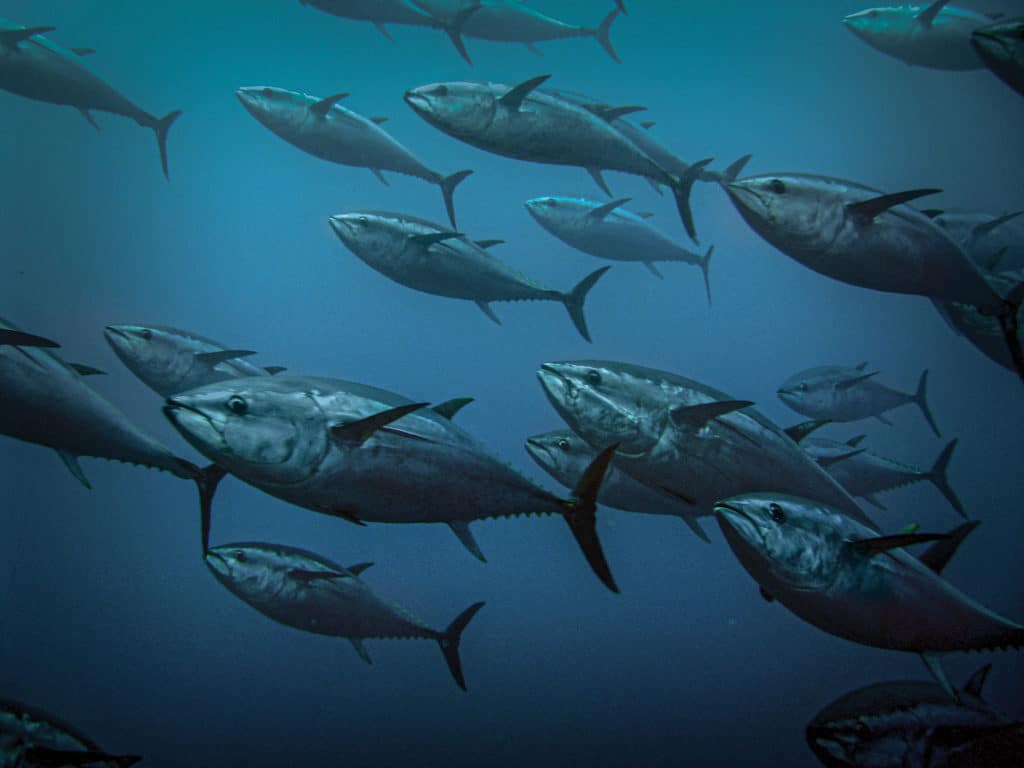
It was midnight aboard the 92-foot party boat Royal Star when the captain’s voice crackled good news over the PA. He had detected a school of bluefins swimming about 200 to 250 feet under the boat.
While most anglers had sacked out in the bunk room, two brothers—Ron and Steve Ballanti—remained on deck with a handful of other anglers and crew. As the diesels throttled down, the duo grabbed their rods and quickly dropped flat-fall jigs to intercept the fish.
“My jig stopped sinking about 200 feet below the surface,” Ron says. “I felt a tick in the line, as if it had hit the bottom.” But it was not the bottom. The tick was the jig hitting the back of the throat of a 60-pound bluefin. “I wound down, set the hook and got solid on the fish.”
Bluefins are brutally strong, but Ballanti applied heavy pressure. After about 15 minutes, the fish was close enough to flash color, illuminated by the glow of Royal Star’s floodlights. Moments later, crewmembers gaffed the tuna and it hit the deck.
Both Ballanti brothers went back to work, each landing two chunky Pacific bluefins and filling their daily bag limits within 40 minutes of the new day before any other anglers even woke up.
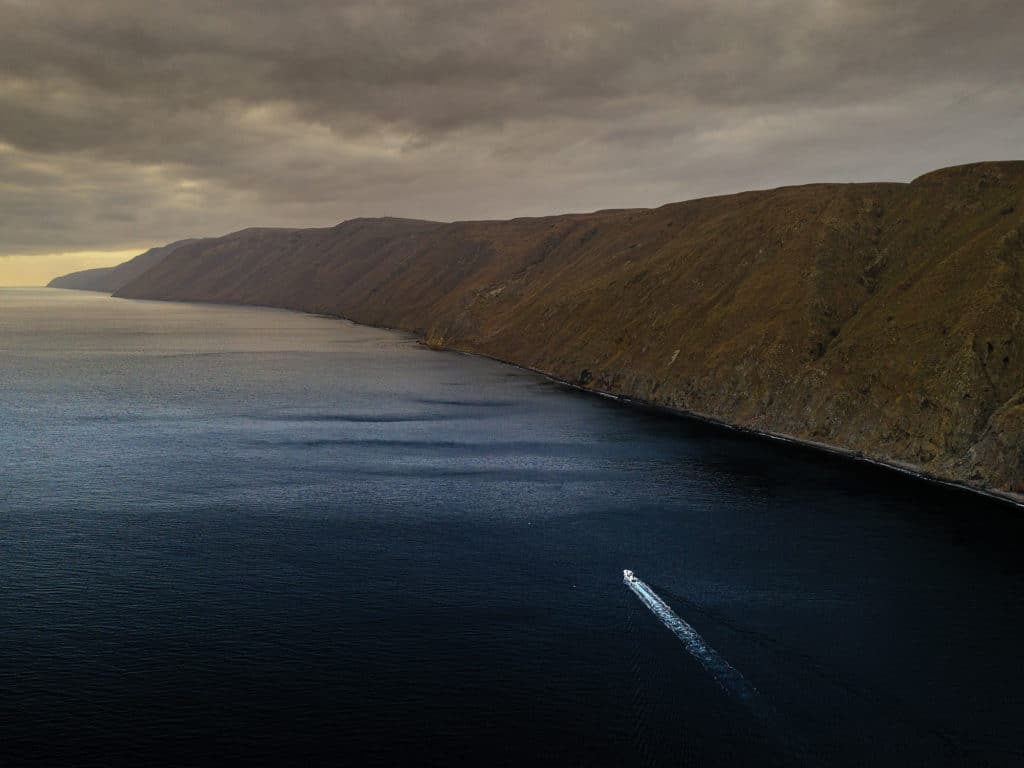
Night Fishing for Tuna
Over the past six years, bluefin tuna fishing has exploded off the coast of Southern California. Anglers fishing from private and party boats have landed fish weighing more than 300 pounds. With a steady supply of forage, including massive schools of pelagic red crabs, anchovies and squid, and influxes of less-mature school tuna in the 40- to 80-pound range every season, there’s every indication that the bluefin numbers will remain strong as long as the food holds.
A number of effective techniques have emerged for targeting SoCal bluefins, including run-and-gun fishing when tuna feed at the surface, slow-trolling with live baits, and kite-fishing with rigged flying fish. Yet for anglers willing to sacrifice some sleep, jigging at night can be the most effective method of all.
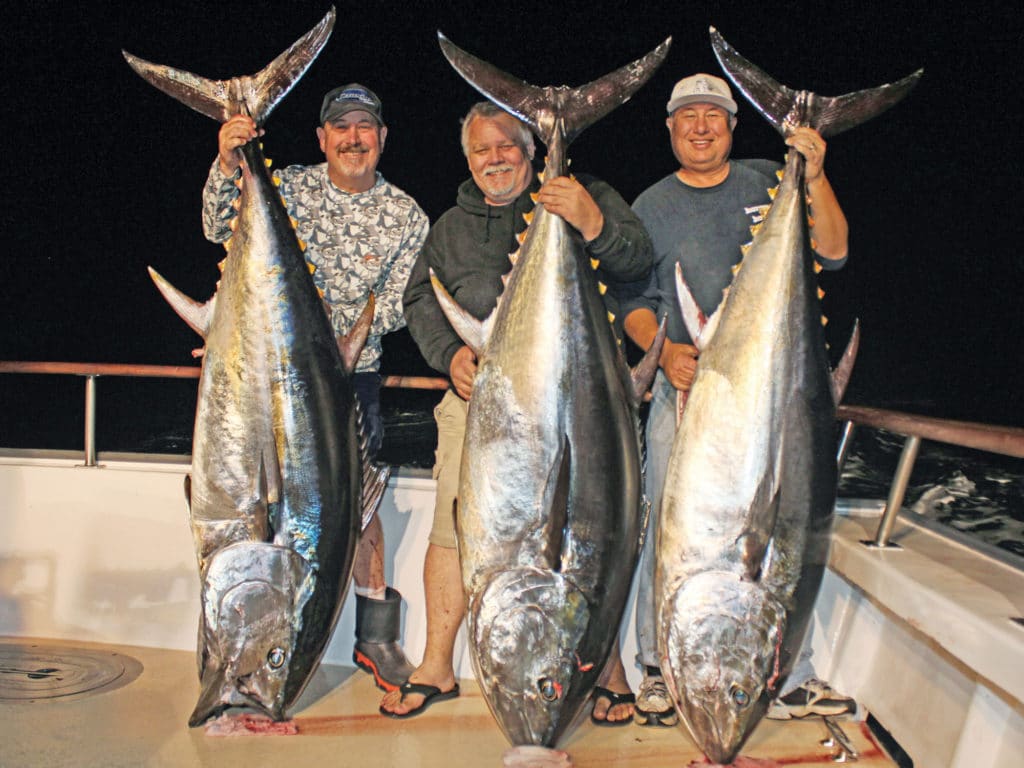
Party Boat Fishing for Bluefin Tuna
Finding the right area to fish for bluefins represents the first step to success. Party boats such as the San Diego-based Royal Star and others have a leg up on private boaters in this particular regard.
Members of the tight-knit party-boat community constantly share information. This allows them to focus on the last-known coordinates of nomadic schools of bluefins, and then, if necessary, expand the search. Many times, the fish are found relating to undersea ridges and seamounts, such as Desperation Reef south of the lower end of San Clemente Island or the 43-fathom spot to the southeast of the island.
Ocean-satellite-imaging websites, like tempbreak.com, and on-water satellite services such as SiriusXM Fish Mapping can offer more clues, particularly sea-surface temperature and chlorophyll breaks. Bluefins often hunt along these edges for schools of anchovies, squid and other forage. When the chlorophyll and temp fronts align, fishing can turn spectacular, both day and night.
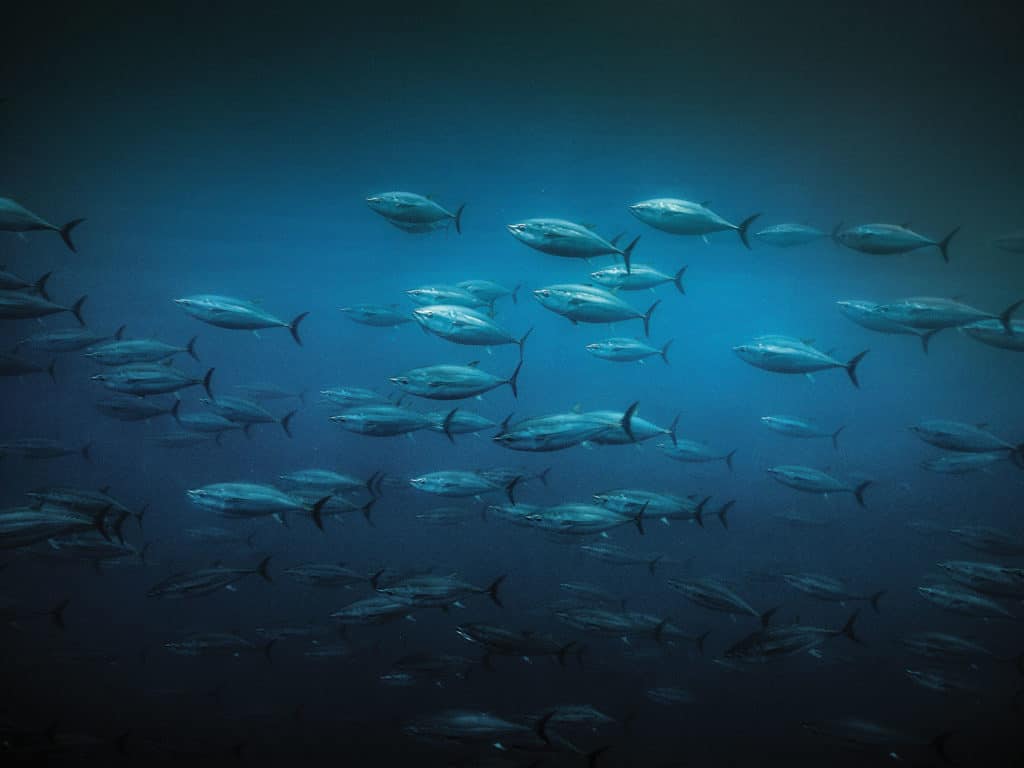
Bluefin Tuna Movement at Night
The quest to find bluefin tuna at night often starts where they were discovered when the sun was up. It’s not unusual for bluefins to be frustratingly hard to catch during daylight hours. Some blame boat traffic. Others point to the predominant forage, such as tiny anchovies. Tuna might be spotted whipping the surface to a froth as they feed on the minuscule morsels. But once bluefins fixate on these, matching the hatch and coaxing a bite turn difficult.
At night, however, bluefins tend to retreat to the depths, some believe to intercept schools of squid and other forage rising from the abyss each night with the marine biomass known as the deep scattering layer. It is at this time when bluefins become especially susceptible to deep jigging.
Locating Tuna in Deep Water
There’s no magic bullet to locating deep-dwelling schools of bluefin tuna. It takes turns on the props and sometimes hours of scanning the depths with a fish finder. But there is a prime depth zone in which to search, says San Diego-based angler Capt. Barry Brightenburg.
“Thirty to 60 fathoms (180 to 360 feet) is the prime zone at night,” Brightenburg says. “Tuna found above 50 fathoms tend to bite better than those found below that depth.”
If you mark just a few fish, say from four to 10 tuna, they are usually big ones—of 150 pounds or more—that travel in wolf packs, Brightenburg says. “Those can be tough to stay on top of, so you really want to see a lot of fish on the screen. They might be smaller, but they will be more eager and easier to catch.”
Jig Fishing for Bluefin Tuna
Anglers need to drop their jigs as soon as possible once tuna are located. The jig of choice for nighttime bluefins was first popularized by Shimano with its Butterfly Flat-Fall series, but the success of these lures has spawned a host of imitators.
Shimano’s Flat-Fall jigs, ranging from 130 to 300 grams, prove the most popular in shades such as Super Glow, Purple Silver and Blue Sardine. In a mild drift, lighter weights work, but as the drift speed increases, so does the need for heavy jigs.
The fluttering action as the lure descends is often what triggers a strike, and the theory is that it mimics a squid darting downward. “Seventy to 80 percent of the bites come during the sink,” Brightenburg says.
Working the lure up and down once it is in the strike zone also can be effective. “I like to wind up with 10 to 15 turns of the reel handle and let it drop again,” Ron Ballanti says. “But it is usually when I drop back down that it gets bit.”
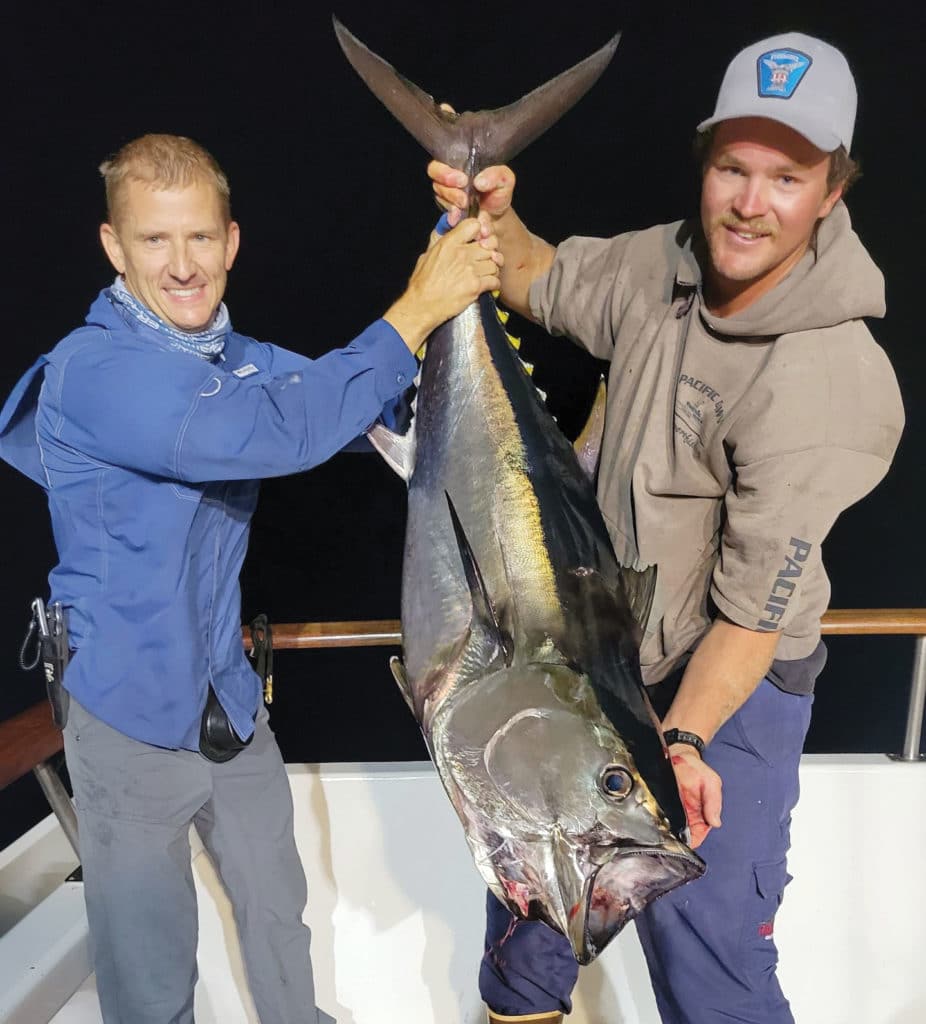
Fishing the Best Depth for Tuna
Knowing the approximate depth of the jig is critical to success with this technique. To ensure that it’s not too far above or below the fish, Ballanti marks his white 80-pound braided line with a black Sharpie marker at 100 feet, and then at 50-foot intervals after that.
“If the fish are showing on the fish finder at 200 feet, I’ll drop down about 250 feet of line before I start working the lure back upward,” he explains.
Brightenburg also uses 80-pound line, but prefers a multicolored braid such as PowerPro Depth Hunter, which changes color every 25 feet. “If I want to let out 250 feet of line, it’s simple, counting 10 colors,” he explains.
Dead Sticking for Bluefin Tuna
When preceded by a long day of hard fishing, spending the night trying to catch fish might not appeal to all anglers. “Some people think night is for sleeping,” Brightenburg jokes.
“When we overnight offshore, I put out a couple of sticks in the rod holders, drop jigs to the approximate strike zone, and let them bounce with the wave action,” he says.
“This kind of fishing is not feasible on a party boat, but on a private boat we hook a fair number of bluefins using dead sticks,” Brightenburg reveals. He suggests loosening the drag a little and keeping the clicker on to alert everyone to a strike.
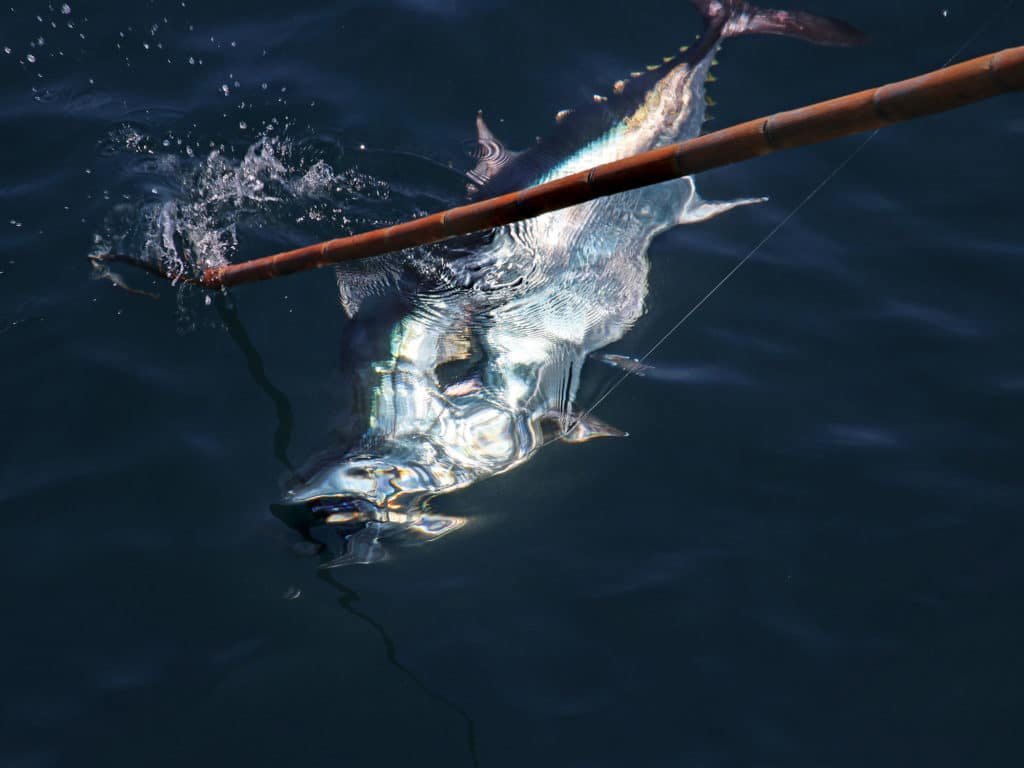
Bluefin Tuna Feeding Frenzy
Curiously, hooking one bluefin tuna at night frequently leads to many more. “The more people hook fish, the better the fishing gets,” Brightenburg says.
He theorizes that a hooked fish activates others through its panicky vibrations and by spitting up food as it fights in the deep, which chums other bluefins into a feeding frenzy.
During these times, the school might also ascend in the water column. “Make sure you’re paying attention to the captain or the fish finder,” Ballanti says, “so that you’re keeping the jig in the strike zone all of the time, especially if the school of tuna is coming up closer.”
Pacific bluefin tuna ranks as one of the most skittish of all pelagic gamefish during daylight hours, but that changes considerably after dark. If you want the best chance of success, just head to the dark side and get ready to work the night shift.
Flat-Fall Jigging for Bluefin Tuna
Most flat-fall jigs come standard with two assist hooks at the bottom, but SoCal bluefin anglers often transfer the assist hooks to the top and add a single hook, such as a 9/0 Owner Offshore or Mustad 7691, to the bottom of the jig with a heavy-duty split ring. This adds a hook, and also provides some insurance in case a big bluefin tuna chews through the cords (used to attach the assist hooks) during a prolonged fight. To further prevent biteoffs, anglers use 150- to 200-pound fluorocarbon leaders ranging between 4 and 5 feet in length, crimped (with chafe protection) to the jig and a heavy-duty swivel at the top of the leader. The main line (80-pound-test braid) is tied to the swivel with a knot such as the San Diego jam.
SWS Planner: Bluefin Tuna from 40 to 300 Pounds
- Where: Offshore banks and ridges along the coasts of Ventura, Los Angeles, Orange and San Diego counties
- When: At night, from May to November
- Who: Anglers with boats of 25 feet and up. Looking for a charter? Here are three choices:
- Lucky B. Sportfishing (private charter), 760-445-4834, luckybsportfishing.com
- Royal Star Sportfishing (party boat), 619-224-4764, royalstar.net
- Pacific Dawn Sportfishing (party boat), 619-269-2186, pacificdawn.com
SWS Tackle Box
- Rods: 7-foot heavy-action jig rods rated for 40- to 60-pound-test
- Reels: Medium-size, two-speed lever-drag reels such as an Okuma Makaira MK 20II or a Shimano Talica TAC20II
- Line: 80-pound braid, white or multicolored
- Terminal Rigs: 4 to 5 feet of 150- to 200-pound fluorocarbon leader
- Lures: Jigs such as the Shimano Butterfly Flat- Fall in 130- to 300-gram models in colors including Super Glow, Purple Silver and Blue Sardine









